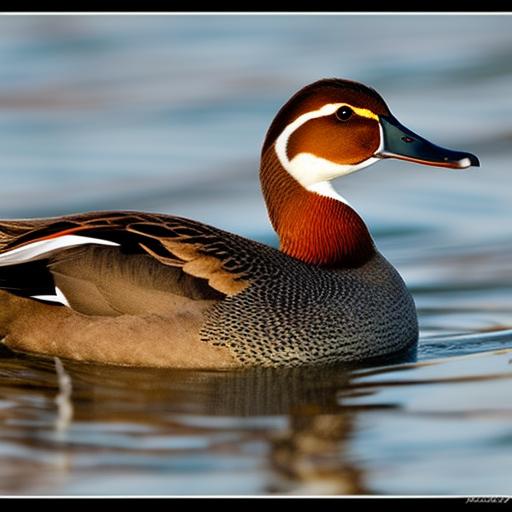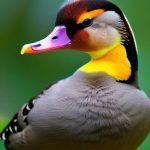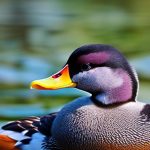Brown ducks are a popular choice among duck enthusiasts for their unique characteristics and versatility. These ducks are known for their beautiful feather colors and patterns, as well as their excellent egg-laying ability and meat quality. Whether you are looking to add some beauty to your backyard or seeking a reliable source of eggs and meat, brown ducks are a great choice.
Key Takeaways
- Brown ducks are a popular breed of domestic ducks that come in various shades of brown.
- They are known for their hardiness, adaptability, and good egg-laying abilities.
- Brown ducks have a long history of domestication and have been bred for different purposes, such as meat, eggs, and ornamental purposes.
- Some popular brown duck breeds include the Khaki Campbell, Rouen, and Indian Runner.
- Brown ducks have a distinctive physical appearance, with a broad, flat bill, webbed feet, and a plump body. They are generally friendly and sociable, making them great pets or farm animals.
Characteristics of Brown Ducks
Brown ducks come in various sizes and weights, depending on the breed. Generally, they range from medium to large in size, with weights ranging from 4 to 10 pounds. Their feather color and pattern can vary greatly, with shades of brown, black, and white being the most common. Some breeds have distinct patterns, such as the Rouen duck with its striking mallard-like plumage.
In terms of egg-laying ability, brown ducks are known for being excellent layers. They can lay anywhere from 150 to 300 eggs per year, depending on the breed and individual bird. The eggs are typically medium to large in size and have a rich flavor. When it comes to meat quality, brown ducks are highly regarded for their tender and flavorful meat. They have a good meat-to-bone ratio, making them a popular choice for those looking to raise ducks for meat.
History of Brown Duck Breeds
The origins of brown ducks can be traced back to various parts of the world. Some breeds, such as the Pekin duck, originated in China and were brought to the West in the 19th century. Others, like the Muscovy duck, have roots in South America and were introduced to Europe in the 16th century.
Over time, these ducks were selectively bred for specific traits such as egg-laying ability, meat quality, and feather coloration. Breeders focused on developing breeds that would excel in certain areas while maintaining their overall hardiness and adaptability. Today, there are numerous brown duck breeds that have been developed and bred for specific purposes.
Popular Brown Duck Breeds
There are several popular brown duck breeds that are widely recognized and sought after by duck enthusiasts. These include the Pekin, Rouen, Muscovy, Cayuga, and Indian Runner ducks.
The Pekin duck is one of the most popular breeds due to its excellent meat quality and high egg production. It has a white feather color and a calm temperament, making it a great choice for backyard enthusiasts.
The Rouen duck is known for its striking plumage, which closely resembles that of the wild mallard. It is a large breed with excellent meat quality and decent egg-laying ability. The Rouen is often used for ornamental purposes due to its beautiful appearance.
The Muscovy duck is unique among brown ducks as it has a distinct appearance and behavior. It has a black feather color with white patches and a red face. Muscovy ducks are known for their excellent meat quality and their ability to control pests such as mosquitoes and flies.
The Cayuga duck is named after Cayuga Lake in New York, where it was first developed. It has a beautiful iridescent green-black feather color and is known for its good egg-laying ability. The Cayuga duck is also valued for its meat quality.
The Indian Runner duck is a slender breed with an upright posture, resembling a wine bottle. It comes in various colors, including brown, black, and white. Indian Runner ducks are excellent layers, often surpassing 200 eggs per year.
Physical Appearance of Brown Ducks
Brown ducks come in various shapes and sizes, depending on the breed. They have a medium to large body size, with males typically being larger than females. Their feathers can range from shades of brown to black, with some breeds having distinct patterns or markings.
The Pekin duck has a plump body with white feathers and a yellow bill. It has a rounded head and a calm expression. The Rouen duck closely resembles the wild mallard, with its green head, brown body, and distinctive blue wing patches. The Muscovy duck has a unique appearance, with its black feathers, white patches, and red face. It has a slender body and a long, thin neck.
The Cayuga duck has a beautiful iridescent green-black feather color that shimmers in the sunlight. It has a medium-sized body and a slightly curved bill. The Indian Runner duck is known for its upright posture and slender body. It has a long neck and a small head, with various color variations depending on the breed.
Temperament and Behavior of Brown Ducks

Brown ducks are generally friendly and sociable birds that can interact well with humans and other animals. They are curious by nature and enjoy exploring their surroundings. Brown ducks are also known for their calm temperament, making them easy to handle and train.
These ducks have natural instincts and habits that are important to understand when raising them. They are excellent foragers and will happily eat insects, slugs, and other small creatures they find in the environment. Brown ducks also enjoy swimming and should have access to water for bathing and preening.
Breeding and Rearing Brown Ducks
Breeding brown ducks is relatively straightforward, but there are some important considerations to keep in mind. Ducks reach sexual maturity at around 5 to 6 months of age, at which point they can start breeding. It is best to have one male for every four to six females to ensure successful mating.
To hatch ducklings, you will need to provide a suitable nesting area for the female duck. This can be as simple as a secluded spot with some straw or hay for bedding. The female will lay her eggs over the course of a few days and then begin incubating them. Duck eggs typically take around 28 days to hatch.
Raising ducklings requires providing them with a warm and safe environment. They should be kept in a brooder with a heat lamp to maintain the appropriate temperature. Ducklings also need access to clean water for drinking and swimming, as well as a balanced diet of duckling starter feed.
Health and Care of Brown Ducks
Brown ducks are generally hardy and can adapt well to various environments. However, there are some common health issues to be aware of and preventive measures you can take to ensure the well-being of your ducks.
One common health issue is respiratory infections, which can be caused by poor ventilation or exposure to damp conditions. Providing a clean and dry living environment for your ducks is essential in preventing respiratory problems. Regular cleaning of their housing and ensuring good air circulation will help keep them healthy.
Another health concern is parasites, such as mites and lice. Regularly inspecting your ducks for signs of infestation and treating them with appropriate medications will help keep these pests at bay. Ducks should also be provided with access to clean water for bathing, as this helps keep their feathers clean and free from parasites.
Proper nutrition is crucial for the overall health of brown ducks. They should be fed a balanced diet that includes a mix of commercial duck feed, fresh greens, and insects. Providing clean water for drinking and swimming is also important, as ducks need water to aid in digestion and maintain their overall health.
Uses of Brown Ducks
Brown ducks have various uses, making them a versatile addition to any farm or backyard. They are valued for their egg production, meat quality, pest control abilities, and ornamental purposes.
Brown ducks are excellent layers, with some breeds capable of producing over 200 eggs per year. Their eggs are nutritious and have a rich flavor, making them highly sought after by those who prefer farm-fresh eggs.
In terms of meat production, brown ducks are known for their tender and flavorful meat. They have a good meat-to-bone ratio, making them a popular choice for those looking to raise ducks for meat.
Ducks, including brown ducks, are also effective at controlling pests such as mosquitoes and flies. They enjoy eating insects and can help reduce the population of these pests in your backyard or farm.
Lastly, brown ducks are often kept for ornamental purposes due to their beautiful feather colors and patterns. They can add a touch of beauty to any landscape and are a joy to watch and interact with.
The Beauty and Utility of Brown Duck Breeds
In conclusion, brown ducks are a popular choice among duck enthusiasts for their unique characteristics and versatility. They come in various sizes, feather colors, and patterns, making them a visually appealing addition to any farm or backyard. Brown ducks are known for their excellent egg-laying ability and meat quality, making them a valuable asset for those seeking a reliable source of eggs and meat.
Whether you are looking to raise ducks for their utility or simply want to enjoy their beauty, brown ducks are a great choice. They are friendly, sociable birds that can interact well with humans and other animals. With proper care and attention to their health and well-being, brown ducks can thrive and provide years of enjoyment.
If you are considering raising brown ducks, take the time to research the different breeds and their specific needs. Each breed has its own unique characteristics and requirements, so it is important to choose the breed that best suits your goals and circumstances. By learning more about brown ducks and their care, you can make an informed decision and embark on a rewarding journey of raising these beautiful birds.
If you’re interested in learning more about brown duck breeds, you might also find this article on “What Should You Feed Ducks?” from Poultry Wizard to be helpful. It provides valuable information on the ideal diet for ducks, including the types of food they should consume and the feeding schedule to follow. Understanding their nutritional needs is essential for their overall health and well-being. Check out the article here to ensure you’re providing your brown ducks with the best possible diet.
FAQs
What are brown duck breeds?
Brown duck breeds are a group of domestic ducks that have brown feathers. They are commonly raised for meat, eggs, and as pets.
What are some examples of brown duck breeds?
Some examples of brown duck breeds include the Rouen, Muscovy, Pekin, Khaki Campbell, and Indian Runner.
What is the size of brown duck breeds?
The size of brown duck breeds varies depending on the breed. Some breeds, like the Muscovy, can weigh up to 15 pounds, while others, like the Indian Runner, are much smaller and weigh around 4 pounds.
What is the lifespan of brown duck breeds?
The lifespan of brown duck breeds varies depending on the breed and the care they receive. On average, domestic ducks can live up to 10 years.
What is the temperament of brown duck breeds?
The temperament of brown duck breeds varies depending on the breed and the individual duck. Some breeds, like the Pekin, are known for being friendly and docile, while others, like the Muscovy, can be more aggressive.
What is the diet of brown duck breeds?
The diet of brown duck breeds consists of a mix of commercial duck feed, grains, and fresh vegetables. They also require access to clean water for drinking and bathing.
What is the breeding season for brown duck breeds?
The breeding season for brown duck breeds varies depending on the breed and the climate. Generally, breeding season occurs in the spring and summer months.
What is the egg-laying capacity of brown duck breeds?
The egg-laying capacity of brown duck breeds varies depending on the breed and the individual duck. On average, domestic ducks can lay up to 300 eggs per year.
Meet Walter, the feathered-friend fanatic of Florida! Nestled in the sunshine state, Walter struts through life with his feathered companions, clucking his way to happiness. With a coop that’s fancier than a five-star hotel, he’s the Don Juan of the chicken world. When he’s not teaching his hens to do the cha-cha, you’ll find him in a heated debate with his prized rooster, Sir Clucks-a-Lot. Walter’s poultry passion is no yolk; he’s the sunny-side-up guy you never knew you needed in your flock of friends!







